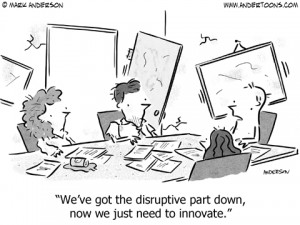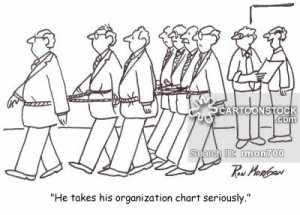Student
A Lesson in Disruptive Innovation
http://www.cio.co.nz/article/565828/lesson-disruptive-innovation/
Jon Rice and Sean Walters were able to take the concept of disruptive innovation and apply it to the recruitment industry (which they said “was ripe for innovation”) by founding virtualRPO. As it’s name implies, it is a virtual platform that provides companies with their own dedicated recruitment professional, whose services they only pay for when they use.
All of their systems are cloud based and they boast that they can “deliver a better hire for half the cost.” This especially appeals to high growth companies, such as My Food Bag, because virtualRPO has contingent, flexible services that don’t force permanent and salaried recruitment functions.
Lastly, there is currently a rise in demands (that isn’t being met) for experience with cloud software, mobile, Enterprise applications and big data analytics, which is causing something of a talent war in this market segment. Tech and SaaS firms are seeking very similarly skilled individuals, so they are essentially competing against each other. This is a great opportunity for virtualRPO, as a low-cost recruiter, as technological companies need to seek third party help to find people with these skills.
ADTRAN, INC example of an “IT as Engine Room” organization
ADTRAN _ Reinventing the Network
I found this press release on a company that related to our class discussion from the other day. ADTRAN, INC. is a leading global provider of networking and communications equipment. It is reinventing the network with its industry-leading solutions that enable voice, data, video and Internet communcaition across a variety of network infrastructure allowing its customers to evolve, change, and grow.
Which of the four models do you feel this company falls under in regards to its enterprise focus? Why?
I feel this company falls under “IT as Engine Room.” Furthermore, when I was reading this press release I started thinking of something more personal. Financial management practices are not just for companies, so even though our class discussion was focused on financial management practices within a company. I wanted to step outside from that and talk about starting to invest in our futures past school. Being seniors and MIS majors I feel that we should be analyzing the market place we will be joining for knowledge, and investment opportunities. For the most part we are on our own when it comes to our retirement options. There will most likely be no social security for us from the government, and the companies we choose to pursue careers with won’t have much more to offer other then a 401-k. As young adults you might think it is to early to be thinking/planning for retirement, but for us it is not. So my questions to everyone would be:
What financial management practices/strategies could we pursue to ensure we are creating a sustainable future/retirement plan for ourselves so that we can too evolve, change, and grow? Ex: IRS’s, stock market, commodity markets, etc. Also, if you have this set in place for yourself already maybe you could share some of your practices with the class.
Is It a Good Business Model to Pay People to Use Less Electricity?
The Internet of Anything: The System That Pays You to Use Electricity

I found this article about Ohmconnect, a sustainable energy management company. What’s interesting about this company is their business model: they will pay you to use less electricity. Ohmconnect partners up with ISO, the organization that manages California’s electrical grid, and gets user authorization to access the user’s home smart meter and any supported internet-connected devices. It can then track the user’s energy consumption and alert the user of energy spikes, asking you to cut back on power consumption. Based on the user’s baseline energy consumption, as set by the ISO, Ohmconnect can determine the reduced electricity consumption and the amount of money you will be paid. The money saved is split between the energy companies, Ohmconnect, and the user.
This is a unique business model that benefits all parties: the user gets paid for less energy consumption, energy companies save money, Ohmconnect makes money, and the carbon footprint is reduced. With this in mind, can you guys think of any other companies or industries that would benefit from a business model like this? Do you think that there is a better business model that Ohmconnect could be using instead? I personally think this is an effective business model for Ohmconnect to use. I would think that cutting back on your electric bill would be enough to reduce energy consumption, but getting paid to do so would certainly be a good incentive for most people to reduce their consumption. What do you guys think?
Is Apple pursuing a strategic move/big investment at the right time?

Apple Orders More Than 5 Million Watches for Initial Run – Digits – WSJ
As we discussed in class proper execution of a product, service, or application can make or break a company. I found this short article about Apple ordering more than 5 million watches for it’s initial run. Now, that may not seem like a huge number for a company like Apple, but we need to keep in mind that this is the first all-new product since the I-Pad. These watches will do much more than just tell time. They can stream live weather reports, reminder notifications, upcoming calender events and more. The base model watch will run around $350+, and the high end model that comes encased in gold looks like it will cost upwards of $4000+. With all that being said I think this watch is an awesome innovative product and if I had the money I eventually would probably purchase one of the low end models. What are your guys thoughts, and also I have a view questions listed below to be answered.
1. What do you think of Apples strategic production forecasting “plan of record?” Do you believe this is what keeps Apple from going under?
2. Do you think Apple is eager to stretch beyond their current abilities?
3. Does Apple understand other people’s constraints and concerns within the market place?
4. Will Apple recover well from setbacks or failures?
Does your Corporate Structure Stifle your Innovation?
http://washingtontechnology.com/articles/2015/01/15/insights-davis-new-corporate-structures.aspx
By removing these “old fashioned” structures, companies:
1) Can spark innovation among employees who no longer feel confined by their organizational role.
2) Create more informal network relationships across organizational boundaries.
3) Distinguish themselves from competitors.
This article argues that old-style, hierarchical organizational structures are detrimental to technological companies. “It creates a straight jacket that makes organization adaptability to changes in the market impossible.” The argument is that the inflexibility of a rigid corporate structure creates a “straight jacket” for firms’ innovation, because employees are always consumed by the operations within their business unit.
Davis also argues that these organizational structures prevent network relationships across organizational boundaries. Creating incentives/rewards for this kind of communication needs to be available to drive cooperation.
Lastly, Davis points out that if all companies have a hierarchical organizational structure, that it is not distinguishing itself from its competitors. A person at Firm A can quit and start working a similar position at Firm B the next week, and would need minimal training because the systems/processes across these organizations are almost identical.
Apple HealthKit
I was doing some research on healthcare management and found this article on Apple’s HealthKit application. This application allows patients to input personal data, such as weight, blood glucose, heart rate and blood pressure. This information is transmitted through the cloud to healthcare providers. This can then be utilized to catch early indicators of disease and allow healthcare providers to treat an issue before it becomes more serious. This will ultimately lead to improved survival rates. Other areas of the medical industry utilizing this type of technology include assisted living, home monitoring, and clinical trials. One of the problems with this type of technology is data security. Because it uses cloud storage to improve its connectivity and data sharing, there is a serious threat to theft and data manipulation.
Personally I find this interesting because of the benefits this could provide. Over time, this data can be used to establish trends which would allow health professionals to determine what activities/actions lead to certain health outcomes. I also think it could allow for better health insurance pricing. For example, if you had two people on diabetes management plans, health insurance providers could see which customers are following their health plan and which ones aren’t. The idea here being that people who are compliant with their health plans will use fewer medical services, leading to a reduction in spending on medical services. Health insurance providers could then adjust payments based on health plan compliance.
Outside of benefits mentioned in the article, what benefits do you see from using Apple’s HealthKit? Is there any technology that could be used in conjunction with this? Do you have any suggestions for solving this data security problem? Do you see any other threats to healthcare data security as a result of cloud storage?
Taking an Investment Management Approach to IT

This article about managing IT projects features an interview with Joe Spagnoletti, CIO of Campbell Soup Company. Spangoletti discuses how he approaches the responsibilities of IT projects and who is accountable for the result. He states that Campbell Soup is moving from an order taking model to a demand driving model. This new model empowers business managers to have more say in IT investments and the IT project portfolio. This means that IT employees work closer with the business side of the company to have a better understanding of the business manager’s desired impact of the project. There are some negatives with this model. The first is determining who owns the decisions. It can be ambiguous who is responsible when an IT employee proposes an idea and the business employee accepts the plan. Another negative is that IT can face more scrutiny under this model. There is more transparency with IT costs and how much value is actually achieved. This puts IT under a magnifying glass and which can seem threatening to the department. Spagnoletti echoes one of the most important concepts of our class: IT decisions need to align with the business strategy. When IT works alone, the business does not get what it needs.
Where would we fall in this business/IT interaction? Would we be middlemen? How can companies face some of the downsides to this model?
Documentation and Over-Documentation

In exploring project documentation techniques online, I found an excerpt from a software quality management book that illustrates the need for a balance between sufficient documentation and “over-documentation.” Some of the information was redundant to what we have learned in class; of course, certain documents are mandatory (project charter), and project scope largely dictates the extent of documentation required—wide-scoped projects need more and narrow-scoped projects need less. At the least, the author describes, documentation must perform the core functions of explaining “what to do (concept and requirements), how to do it (plan and design), how to show that it was done (test), and how to use the system (user).” However, too much documentation creates issues. The author warns that along with inducing an immediate “I’m not going to read all that!” response, over-documentation can result in inconsistencies that create confusion and damage progress.
The process for developing our ideas into interactive prototypes over the course of this semester is not as structured as it was in MIS3535. In that class, specific documents were due each week, and revisions of key documents were also expected regularly. In MIS4596, we are given more general instructions; many of the project tasks we perform—such as deciding the extent of documentation—are self-directed. Given that we have control of our projects’ direction, I expect teams’ documentation to range from minimal to very thorough.
With the hazards of over-documentation in mind, how will your team ensure that your project documentation is both manageable and thorough? How will you check for inconsistencies between documents? Lastly, which documents used in our business analysis and project management classes will you employ this semester, and which will you disregard?
Are Employees the Bigger Issue in Cyber Security?

Cisco Systems, Inc. (CSCO): Firms Should Also Focus On Employees For Cyber Security
Billions spent on cyber security and much of it ‘wasted’
I found this article from last month in which Terry Greer-King, Cisco’s director of security, said that the focus on IT security should be people. This contrasts from the common notion that not enough money is spent on effective security. This also contrasts the common belief among businesses that IT functions should be left to just IT. I completely agree with Greer-King. IT security cannot be left to just IT; everyone needs to know how to keep their devices secure. All it takes it one compromised device for an entire system to be compromised. Last year, $49.8 billion was spent on cyber security (referenced from the second article), so the infrastructure is certainly in place. But if there aren’t enough competent people to utilize the technology, then security will continue to be a major issue.
What do you guys think is the most important factor of IT security? Do you agree with Terry Greer-King that employees need to be better trained, or that better security technology needs to be in place? Are there any factors to this that you feel are missing or lacking?
“Cyberattacks” Is our information really secure?
Debate Deepens Over Response to Cyberattacks – WSJ
I ran into this article shortly after reading Jessica’s topic regarding information security. I see information security as one of the greatest concerns for businesses today; especially, ones that collect client/customer information, which in this day and age most companies do. I know it may not seem like a huge deal that hackers obtained control over government social media accounts, but is this a risk management red flag that should be taken much more seriously? It makes me think about BP oil company, or Sony. If hackers can breach government firewalls, and security protocols what makes Amazon, Facebook, or any other company that collects our personal information safe?
Why do you think there is a sudden increase in company security breaches? Are companies getting lazy with IT security, or are hackers just getting smarter?






